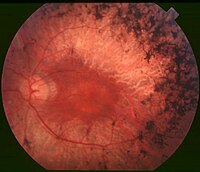
Photo from wikipedia
Aims To report the clinical manifestations, ultrastructure and evaluate the efficacy of therapeutic lamellar keratectomy (TLK) and penetrating keratoplasty (PK) for microsporidial stromal keratitis (MSK). Methods Fourteen MSK cases between… Click to show full abstract
Aims To report the clinical manifestations, ultrastructure and evaluate the efficacy of therapeutic lamellar keratectomy (TLK) and penetrating keratoplasty (PK) for microsporidial stromal keratitis (MSK). Methods Fourteen MSK cases between 2009 and 2018 were recruited. Each patient’s clinical presentation, light microscopy, histopathology, PCR and electron microscopy (EM) of corneal samples were reviewed. Results The patients were 70.0±4.7 years old (average follow-up, 4.5 years). Time from symptoms to presentation was 10.6±13.0 weeks. The corneal manifestations were highly variable. Corneal scrapings revealed Gram stain positivity in 12 cases (85.7%) and modified Ziehl-Neelsen stain positivity in 9 (64.3%). Histopathology revealed spores in all specimens, while sequencing of small subunit rRNA-based PCR products identified Vittaforma corneae in 82% of patients. EM demonstrated various forms of microsporidial sporoplasm in corneal keratocytes. All patients were treated with topical antimicrobial agents or combined with oral antiparasitic medications for >3 weeks. As all patients were refractory to medical therapy, they ultimately underwent surgical intervention (TLK in 7, PK in 6 and 1 received TLK first, followed by PK). Postoperatively, the infection was resolved in 78.6% of the patients. Nevertheless, a high recurrence rate (21.4%) was noted during 3-year follow-up, with only two patients retained a final visual acuity ≥20/100. Conclusion MSK usually presents with a non-specific corneal infiltration refractory to antimicrobial therapy. The diagnosis relies on light microscopic examinations on corneal scrapings and histopathological analyses. Surgical intervention is warranted by limiting the infection; however, it was associated with an overall poor outcome.
Journal Title: British Journal of Ophthalmology
Year Published: 2020
Link to full text (if available)
Share on Social Media: Sign Up to like & get
recommendations!